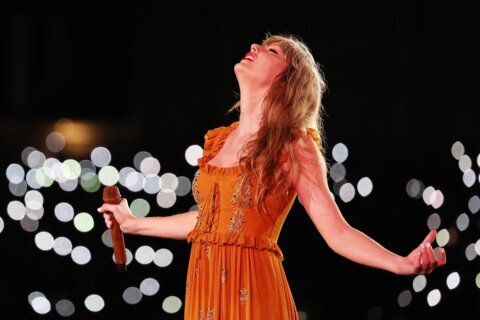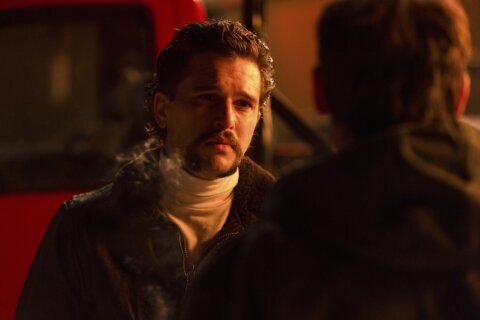WASHINGTON — From Lon Chaney’s 1925 silent film to Gerard Butler’s 2004 flick, “Phantom of the Opera” has existed in countless forms over the years.
But it didn’t become the cultural staple we know and love until 1988, when Andrew Lloyd Webber brought his West End creation to New York’s Majestic Theatre, drilling iconic music into our hearts, winning a whopping seven Tony Awards and sparking the longest-running show in Broadway history.
Now, the classic production is shattering chandeliers in D.C. as part of a brand-new North American tour, which electrifies the Kennedy Center Opera House now through Aug. 20.
Based on the French novel “Le Fantôme de l’Opéra” by Gaston Leroux with a stage book by Webber and Richard Stilgoe, the opera-about-an-opera needs little introduction. Every theatergoer and his mother knows what goes down at the fictional Opéra Populaire in 1881, where beautiful soprano Christine Daaé (Julia Udine) steals the heart of her childhood friend Raoul (Storm Lineberger).
But a mysterious figure at a pipe organ — the Phantom of the Opera (Chris Mann), acknowledged in legend as the mythical “Angel of Music” — lurks in his underground lair beneath the stage. Wearing a half mask to conceal his disfigured face, the Phantom taps his multifaceted genius in theater, music, magic and invention to woo Christine, who has become the subject of his undying obsession.
“He has written such a classic show, and not classic in that it’s old, classic in that it’s iconic,” Udine told WTOP. “It’s a story that everyone can relate to. It’s a story of unrequited love. It’s a story of loving someone else more than you love yourself. … It’s sort of applied to generations time and time again, and to audiences of all ages. That story, combined with this amazing, amazing music — it’s magical.”
Growing up in New Jersey, Udine will never forget the first time she saw “Phantom” on Broadway.
“The first time I saw ‘Phantom of the Opera’ I think I was 9 years old,” Udine said. “I went with my whole family and we sat in the way-up-top balcony. I was entranced the entire time. I completely fell in love with the show and I started singing these songs in voice lessons when I was 10 or 11, so I’ve had quite the experience with ‘Phantom.’ I never imagined I’d be here one day.”
While the role was originated by Sarah Brightman, Udine had the honor of being the first to play Christine in the relaunched U.S. national tour three years ago. She then took the role to Broadway, before returning to the national tour for a brief stint this summer in D.C. and Denver.
“There’s so much I learn about Christine every single night,” Udine said. “You find new moments in the text and in the lyrics. … Maybe one night, this line means that. Maybe the next night, it means something different. But what’s important to remember is that every audience coming to see the show night after night is new. … It’s my job as an actor to make it fresh for them and keep it present.”
Her onstage love triangle consists of Chris Mann, whose Phantom leaves little traces of his July emergency appendectomy as he belts to the rafters, and Storm Lineberger as romantic rival Raoul.
“The reason why the love triangle is so strong is because everyone thinks the story is about themselves,” Lineberger said. “Phantom thinks it’s about him, Christine thinks it’s about her, Raoul thinks it’s about him. Raoul is like, ‘Why is this guy messing with my date? This is my life.”
Such intrusion bleeds from Webber’s signature organ in “The Overture,” its notes descending like the Phantom’s footsteps down the stairs of his lair. It’s instantly recognizable — even by those who have never seen the show — and comes from a deep place within Webber.
“Webber’s background is in choral and organ,” Lineberger said. “His father played in churches all the time at the organ, and I feel like those Davidian melodies are this human melody that lives inside all of us. … It’s just this guttural sound … and I think it just sits within the subconscious of humanity.”
These melodies feature unforgettable lyrics by Charles Hart: the haunting “Angel of Music,” the iconic “Phantom of the Opera,” the romantic “Music of the Night,” the protective “All I Ask of You,” the rousing yet threatening “Masquerade/Why So Silent?” and the fatalistic “Point of No Return.”
“The music is so lush, it’s so romantic; the orchestrations really carry you away,” Udine said. “You walk away from the show singing the songs. That’s sort of always the sign of an amazing show, right? When you’re leaving and you can’t get the songs out of your head. That’s what he’s done with this.”
If the songs are nostalgically familiar, so are the same Tony-winning costumes by Maria Björnson.
“We travel with more than a thousand costumes, more than 100 wigs and hairpieces,” stage manager Javon Shuck said. “Some women wear 40 pounds of costumes, and they quick change in and out of those. So if you wanna be Christine or Carlotta, you better be an athlete. … Some of those costume changes are as fast as 20 seconds. … It’s as choreographed [backstage] as what you see on stage.”
Beyond that, a lot of the show has been re-imagined for the 21st century, featuring new scenery by Paul Brown, new choreography by Scott Ambler and new blocking by director Laurence Connor, who knows Webber well after having collaborated on this year’s Tony nominee “School of Rock.”
“We have all new scenic design, lighting design, sound design,” Shuck said. “We’ve taken advantage of all the technological advances in the last 25 years. … We also have two 10-ton revolving walls that become the scenery for everything. … They’re cinematic the way they work. They can wipe away a scene and reveal a new thing. The show moves along scenically a little faster than it used to.”
This revolving wall is best on display as the Phantom leads Christine through the dressing-room mirror to make their famous descent into his lair. As steps magically appear beneath them, the actors reach the fog-covered floor and climb into a boat, creating the illusion of an underground river.
“It’s really, really cool,” Lineberger said. “Dark and dank. Very Gothic. He’s stolen different set pieces and props from the different productions in the theater to make his bed and his organ throne.”
It’s here that you’ll notice the lighting design by Tony winner Paule Constable.
“In our show, we’ve used light as a character,” Lineberger said. “Our lighting designer wanted to show that in the catacombs of a theater, you don’t really have any light. You’ve got the candelabras and then one little tiny light coming from the surface. So he started from there and really brought in these lush but subtle-in-brightness colors. … When you’re in a really dark place, you can hear the silence.”
While the Phantom’s lair is a perennial audience favorite, the ensuing masquerade ball to start Act Two brings a noticeable difference. Rather than the giant ballroom staircase, we get a cloudy hall-of-mirrors backdrop that was added to make it look like there are even more people dancing at the ball.
“Not to fear, all of the elements of ‘Phantom of the Opera’ that you fell in love with years ago are still there,” Udine said. “The music, costumes, chandelier, characters, the romance — all of that remains.”
“You’re not going to feel like you’re wanting for anything; trust me,” Lineberger added.
Such promises can be confidently made thanks to the production’s real showstopping element: the giant, one-ton chandelier, which lowers to the “Phantom” theme at the start, then rapidly drops just before intermission, “shattering” with fake plastic “glass” all over the floor as the lights come up.
“Our set features a one-ton chandelier with more than 6,000 beads,” Shuck said. “It has pyrotechnic effects, fireworks effects on board. It has smoke and haze and sound and motion effects. It behaves differently than the original chandelier. It has some different tricks up its sleeve. … She’s quite a thing to haul around the country. She can be a little temperamental, as you might imagine.”
It’s truly a wonder to behold seeing the gorgeous chandelier in the Kennedy Center Opera House.
“The Kennedy Center is just a special place to do the show,” Shuck said. “It shows off our show so well in the Opera House. It’s a real jewel box in there. ‘Phantom of the Opera’ in an opera house!”
Click here for ticket information.








